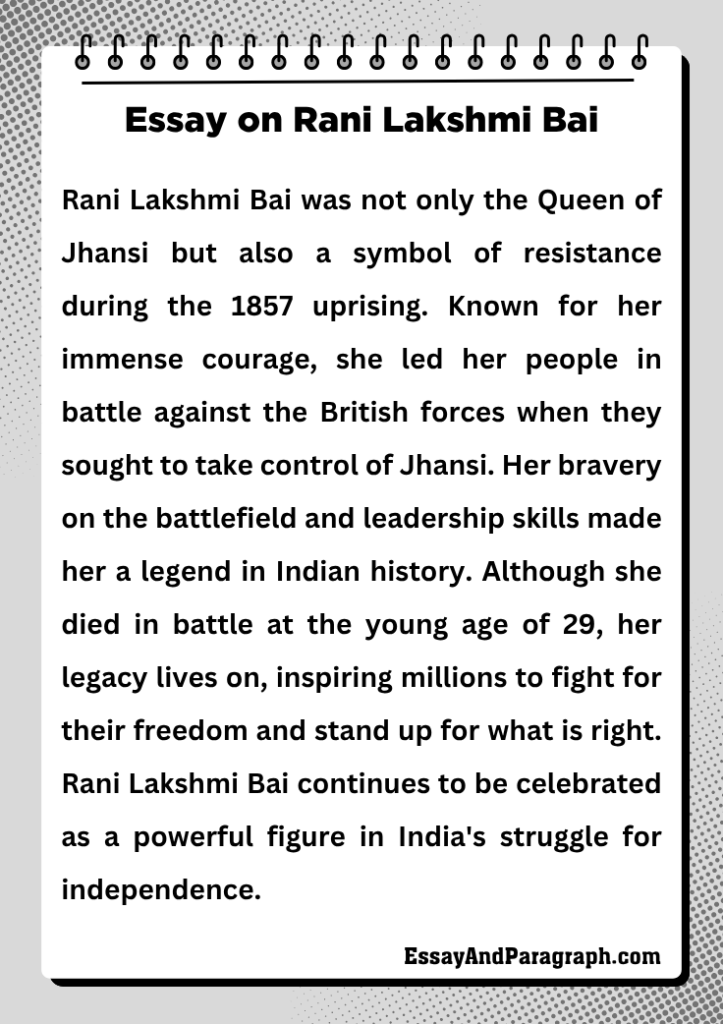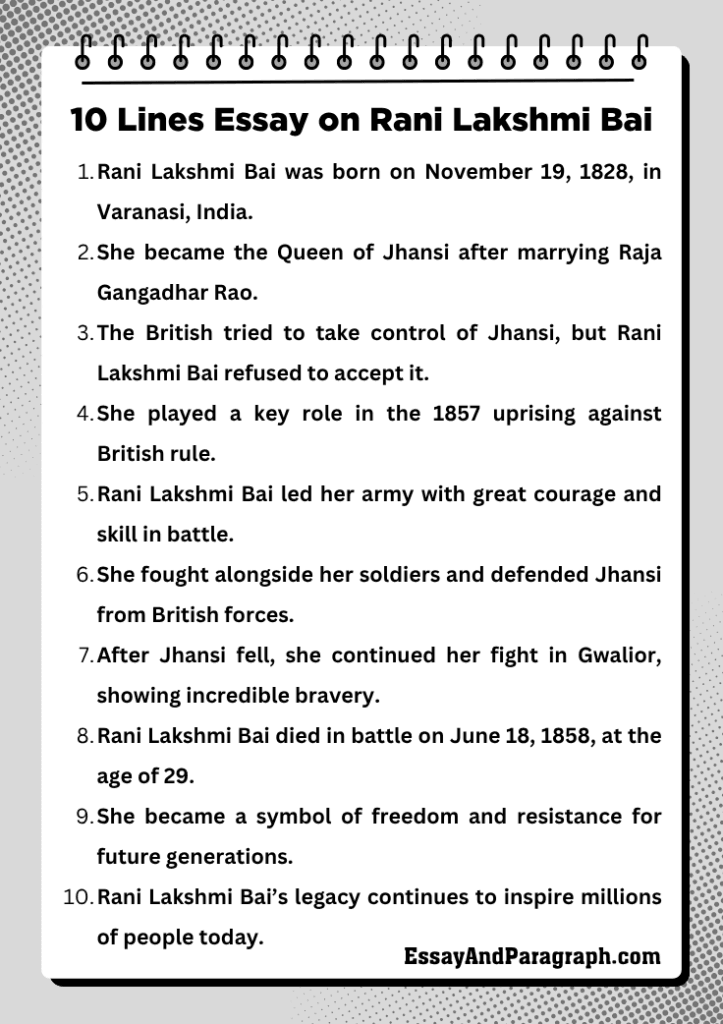Ever heard of Rani Lakshmi Bai, the fearless queen who became a symbol of courage and sacrifice? She is one of India’s most revered figures for her bravery during the First War of Indian Independence. Rani Lakshmi Bai’s life is an inspiring story of a woman who fought for her kingdom and her people, leaving an indelible mark on history. In this article, we will learn how to write an essay on Rani Lakshmi Bai, focusing on her life, courage, and legacy.
10 Lines Essay on Rani Lakshmi Bai
Rani Lakshmi Bai was born on November 19, 1828, in Varanasi, India.
She became the Queen of Jhansi after marrying Raja Gangadhar Rao.
The British tried to take control of Jhansi, but Rani Lakshmi Bai refused to accept it.
She played a key role in the 1857 uprising against British rule.
Rani Lakshmi Bai led her army with great courage and skill in battle.
She fought alongside her soldiers and defended Jhansi from British forces.
After Jhansi fell, she continued her fight in Gwalior, showing incredible bravery.
Rani Lakshmi Bai died in battle on June 18, 1858, at the age of 29.
She became a symbol of freedom and resistance for future generations.
Rani Lakshmi Bai’s legacy continues to inspire millions of people today.

10 Lines Essay on Rani Lakshmi Bai
Essay on Rani Lakshmi Bai – 100 words
Have you ever heard about the brave Rani Lakshmi Bai, the Queen of Jhansi? She is a symbol of courage and strength in Indian history. Born in 1828, Rani Lakshmi Bai played a key role during the First War of Indian Independence in 1857. Despite facing immense challenges, she led her people in battle to protect Jhansi from British rule. Her fearless leadership, courage, and determination made her a legendary figure. Even today, her bravery inspires millions of people worldwide, especially women. In this article, we will learn how to write an essay about Rani Lakshmi Bai.
Essay on Rani Lakshmi Bai – 200 words
Rani Lakshmi Bai, born in 1828 in Varanasi, is remembered as one of India’s most courageous leaders. She became the Queen of Jhansi after marrying Raja Gangadhar Rao. When the British tried to annex Jhansi under the Doctrine of Lapse, Rani Lakshmi Bai refused to accept their control. She led her army during the 1857 uprising, often seen riding a horse and fighting on the battlefield. Despite her valiant efforts, Jhansi was eventually captured by the British after a fierce siege.
Her unwavering spirit and leadership turned her into a symbol of freedom and resistance. Rani Lakshmi Bai’s fight was not just for her kingdom, but for India’s independence. She was also an advocate for women’s rights, showing that women could stand strong in the face of adversity.
Her death in 1858 at the age of 29 while fighting for her people was heartbreaking. However, her legacy lived on, inspiring future generations to stand up for what is right. Today, Rani Lakshmi Bai is celebrated as a true heroine, not only for her strength and leadership but for her undying commitment to India’s freedom.
Short Essay on Rani Lakshmi Bai – 250 words
Rani Lakshmi Bai was born on November 19, 1828, in Varanasi, India. Her birth name was Manikarnika, but she is more famously known as Rani Lakshmi Bai after she married Raja Gangadhar Rao of Jhansi. Following her husband’s death and the British attempt to annex Jhansi under the Doctrine of Lapse, she took charge of the kingdom to fight against British forces in 1857.
Rani Lakshmi Bai led her army with great courage and was not afraid to fight in the battlefield herself. She donned a warrior’s attire, fought on horseback, and wielded a sword with great skill. Her strong leadership and bravery during the siege of Jhansi made her a legendary figure in India’s history.
Her efforts during the First War of Indian Independence are often remembered for her courage, her battle strategies, and her commitment to her people. She became a symbol of resistance against British colonial rule. Despite Jhansi falling to British forces, Rani Lakshmi Bai continued to fight for India’s freedom, even escaping to Gwalior to continue the battle. Unfortunately, she was martyred in 1858, but her legacy of heroism remains forever etched in history.
Her story inspires many, especially women, to stand up for what they believe in. Rani Lakshmi Bai remains one of the most celebrated figures in Indian history.
Long Essay on Rani Lakshmi Bai – 500 words
Rani Lakshmi Bai, the Queen of Jhansi, was one of the most prominent figures during the First War of Indian Independence in 1857. Born on November 19, 1828, in Varanasi, she was originally named Manikarnika, later nicknamed ‘Jhansi Ki Rani’ after her marriage to Raja Gangadhar Rao, the king of Jhansi. Her life would soon become an example of indomitable courage and unwavering leadership.
The British East India Company, led by its doctrine of expansion and control, attempted to annex Jhansi after the death of her husband. According to the Doctrine of Lapse, if a ruler did not have a male heir, their kingdom could be seized by the British. Rani Lakshmi Bai rejected this move, arguing that her adopted son, Damodar Rao, should be recognized as the rightful heir. However, the British were determined to take control of Jhansi.
When the First War of Indian Independence, also known as the Sepoy Mutiny, broke out in 1857, Rani Lakshmi Bai rose as a fearless leader. She played a key role in organizing the defense of her kingdom and led the people of Jhansi against British forces. She personally participated in the battle, showing incredible bravery as she rode into battle, wielding a sword and leading her troops on horseback. Under her leadership, Jhansi became one of the strongholds in the uprising.
The siege of Jhansi in March 1858 was a turning point. After several weeks of fierce fighting, the British forces, under the leadership of Sir Hugh Rose, overpowered the defenders of Jhansi. Despite her best efforts, Rani Lakshmi Bai was forced to retreat. She did not give up, however, and continued to fight in the region of Gwalior, where she rallied soldiers and led guerilla warfare. It was in Gwalior that she met her death, falling in battle on June 18, 1858, at the age of 29.
Though she did not live to see India’s independence, Rani Lakshmi Bai’s legacy as a symbol of resistance and courage lives on. Her life story has been immortalized in numerous books, films, and cultural references, and she continues to inspire millions, especially women.
Rani Lakshmi Bai demonstrated not only bravery but also intelligence and strategic thinking during the battle for Jhansi. Her leadership was revolutionary for the time, as she managed to unite a diverse group of people to fight against a common enemy. She showed the world that women could be powerful warriors, capable of leading armies and shaping the future of nations.
Her bravery is remembered as a key chapter in India’s struggle for freedom, and she remains one of the most celebrated heroes in Indian history. Rani Lakshmi Bai’s contributions to India’s independence are profound, and her courage remains a beacon of inspiration to this day.

FAQs
1. Who was Rani Lakshmi Bai?
Rani Lakshmi Bai, born in 1828, was the Queen of Jhansi and one of the most iconic figures in the First War of Indian Independence in 1857. She was known for her bravery and leadership in defending her kingdom from the British East India Company. Rani Lakshmi Bai fought for her kingdom’s independence and became a symbol of resistance against British colonial rule.
2. What was the significance of Rani Lakshmi Bai in Indian history?
Rani Lakshmi Bai played a crucial role in the Indian Rebellion of 1857. Her defense of Jhansi against British forces made her a national hero. Her courage, military strategy, and leadership in the face of adversity inspired future generations and played an important part in India’s eventual fight for independence.
3. How did Rani Lakshmi Bai die?
Rani Lakshmi Bai died in battle on June 18, 1858, in Gwalior during the uprising. While leading her troops against the British, she was struck down in combat. Despite her death, her legend lived on as a symbol of courage and resistance.
4. Why is Rani Lakshmi Bai a role model for women?
Rani Lakshmi Bai is considered a role model for women because of her leadership qualities, strength, and determination. She defied the expectations of women at the time, leading her army and fighting in battles alongside men. Her legacy has inspired many women to break societal barriers and fight for their rights and freedom.
5. What is Rani Lakshmi Bai’s legacy today?
Rani Lakshmi Bai’s legacy continues to inspire not just Indians but people across the world. She is a symbol of courage, resistance, and leadership. Her story is celebrated in books, films, and public monuments. She is also remembered as a key figure in India’s path toward independence from British colonial rule.
Top 5 Quotes on Rani Lakshmi Bai
“I shall not surrender Jhansi. I will not give up without a fight.”
“If you are the head of the state, you must protect your people at all costs.”
“Courage and determination are the strongest weapons one can have in times of war.”
“I am ready to die, but I will never give in to the British.”
“The fight for independence is not just for freedom, but for the future of the generations to come.”
Summary
Rani Lakshmi Bai was not only the Queen of Jhansi but also a symbol of resistance during the 1857 uprising. Known for her immense courage, she led her people in battle against the British forces when they sought to take control of Jhansi. Her bravery on the battlefield and leadership skills made her a legend in Indian history. Although she died in battle at the young age of 29, her legacy lives on, inspiring millions to fight for their freedom and stand up for what is right. Rani Lakshmi Bai continues to be celebrated as a powerful figure in India’s struggle for independence.


